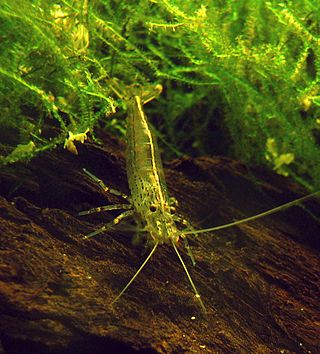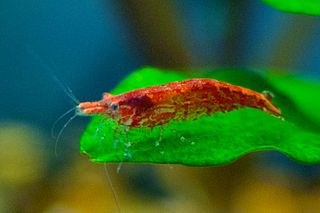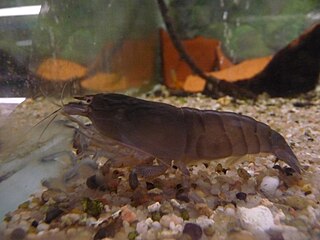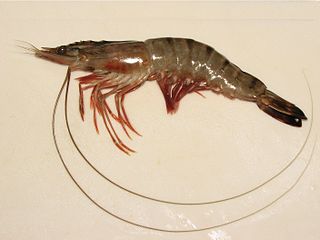
The Caridea, commonly known as caridean shrimp or true shrimp, from the Greek word καρίς, καρίδος, are an infraorder of shrimp within the order Decapoda. This infraorder contains all species of true shrimp. They are found widely around the world in both fresh and salt water. Many other animals with similar names – such as the mud shrimp of Axiidea and the boxer shrimp of Stenopodidea – are not true shrimp, but many have evolved features similar to true shrimp.

Caridina is a genus of freshwater atyid shrimp. They are widely found in tropical or subtropical water in Asia, Oceania and Africa. They are filter-feeders and omnivorous scavengers. They range from 0.9 to 9.8 mm to 1.2–7.4 mm in carapace length.

Atyidae is a family of shrimp, present in all tropical and most temperate waters of the world. Adults of this family are almost always confined to fresh water. This is the only family in the superfamily Atyoidea.

Atyopsis is a genus of freshwater shrimp from Southeast Asia. It was erected in 1983 by Fenner A. Chace, Jr. for two species formerly treated in the genus Atya. It differs from Atya by various characters, including the form of the telson and the presence of a "massive spur" on the male third pereiopod.

Hippolyte is a genus of shrimp in the family Hippolytidae, containing the following species:

Palaemonidae is a family of shrimp in the order Decapoda. Many species are carnivores that eat small invertebrates, and can be found in any aquatic habitat except the deep sea. One significant genus is Macrobrachium, which contains commercially fished species. Others inhabit coral reefs, where they associate with certain invertebrates, such as sponges, cnidarians, mollusks, and echinoderms, as cleaner shrimps, parasites, or commensals. They generally feed on detritus, though some are carnivores and hunt tiny animals.

Palaemon is a genus of caridean shrimp in the family Palaemonidae.

Troglocaris anophthalmus is a species of freshwater shrimp in the family Atyidae. It lives in karstic caves in Bosnia and Herzegovina, Croatia, Italy and Slovenia. Although morphologically similar across its 500-kilometre (310 mi) range, molecular phylogenetics suggests that there are four or five cryptic lineages with more restricted ranges, although one such lineage does range unusually widely for a troglobite – over 300 kilometres (190 mi).

Typhlatya is a genus of shrimp in the family Atyidae. These are small, stygobitic shrimp found in the West Mediterranean region, Caribbean region, Ascension Island and the Galápagos, although the individual species often have very small ranges. Species in this genus are found in salt, brackish and fresh waters, mostly in anchialine habitats and none in the open sea.

Neocaridina davidi is a freshwater shrimp originating from eastern China and northern Taiwan and introduced in the rest of Taiwan, Japan, and Hawaii, which is commonly kept in aquaria. The natural coloration of the shrimp is green-brown, though a wide variety of color morphs exist, including red, yellow, orange, green, blue, violet and black shrimp. Full-grown shrimp reach about 4 centimetres (1.6 in) long. N. davidi shrimp are omnivores that may live 1–2 years. These shrimps have previously been classified as Neocaridina heteropoda and Neocaridina denticulata sinensis, however are now known as Neocaridina davidi which is based on the oldest known published description of the species.

Stygiocaris is a genus of shrimp from caves in the North West Cape and Barrow Island, Western Australia.

Halocaridina is a genus of atyid shrimp. It contains two species – Halocaridina rubra and Halocaridina palahemo – both endemic to Hawaii. H. rubra is widely kept in aquaria.

Macrobrachium is a genus of freshwater prawns or shrimps characterised by the extreme enlargement of the second pair of pereiopods, at least in the male.

Atya gabonensis is a species of freshwater shrimp from West Africa. Note that accounts of its occurrence in South America are erroneous, and likely another species. It is an omnivorous filter feeder that uses feather-like claspers to filter particles from the water. It can grow to 15 centimetres. It has many common names, including African fan shrimp, African filter shrimp, African giant shrimp, vampire shrimp, blue rhino shrimp, Gabon shrimp, and Cameroon fan shrimp.

Prawn is a common name for small aquatic crustaceans with an exoskeleton and ten legs, some of which are edible.

Atya lanipes is a freshwater amphidromous shrimp of the Atyidae family in the Decapoda order. It is found widely in the Caribbean and is common in the Toro Negro State Forest in central Puerto Rico. It is also known as jonga and in some places people refer to it as "guábara” or “chágara”.

Atya scabra is a species of freshwater shrimp in the family Atyidae. Atya scabra can reach a length of about 89 millimetres (3.5 in) in males, while females are generally smaller, reaching about 64 mm (2.5 in). It lives on rocky bottoms in rivers connected to the Atlantic Ocean. The species is widespread from Mexico to Brazil, Jamaica, Hispaniola, and Puerto Rico. In Africa, it occurs from Liberia to Angola, the Cape Verde Islands and the islands of the Gulf of Guinea.

Caridina holthuisi is a species of freshwater shrimp in the family Atyidae, endemic to the Malili lake system in Sulawesi, Indonesia. It can be found in Lake Towuti, Lake Matano, and Lake Mahalona, as well as the Petea river. It is named in honour of Dutch carcinologist, Lipke Holthuis.

















